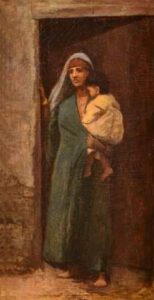One thing I love about writing historical fiction is doing the research. I often have to stop myself digging too deep while I'm working. I love the thrill of following a trail and getting to know new people, and the interconnections between them.
This week I’ve been dropping deep into the life of a woman who seems like a fringe character in the life of WB Yeats, an aunt on his mother's side. She emerged in my research for the prologue to my Yeats-Gonne series, A Life Before This One, which tells the stories of WB and Maud Gonne's fascinating fathers, and their effect on their lives. [More about WB’s father, John Butler Yeats, here]
Aunt Isabella is barely mentioned in the biographies yet it was she, or more accurately a book she lent the poet, that ignited the interest in Eastern philosophies that were such a keen influence on him, and still haunted his poetry on his deathbed, fifty years later.
Isabella Pollexfen Varley, was born in Sligo around 1850 to William Pollexfen and Elizabeth Louisa Middleton, one of 10 younger siblings to her sister Susan, mother of the poet.
Also an artist, Isabella had a passionate interest in the occult, was a founding member of The Theosophical Society, and a close follower of its leader, Madame Blavatsky (of whom more on this blog shortly).
Isabella was particularly interested in the magical lore of Egypt and influenced her husband too, the landscape painter John Varley (1850-1933), who became known as “Egyptian Varley.” Today she is best remembered as the person responsible for inspiring the mystical life of the great Irish poet, her nephew.
Yeats famously said his mystical life was at the “centre of all that I do and think and all that I write”. He had a life long interest in spiritualism, occultism, astrology, and Eastern mysticism, and read extensively on the subjects throughout his life.
“If I had not made magic my constant study I could not have written a single word of my William Blake book, nor would The Countess Kathleen ever have come to exist.
So Isabella Pollexfen Varley had a major influence on Irish literature, by introducing WB to Theosophy and giving him a copy of AP Sinnett's book, Esoteric Buddhism in his late teens.
Isabella Pollexfen Varley: Esoteric Buddhism
In late 1884 Isabella, by then married to John Varley and living in London, sent WBY a copy of A. P. Sinnett‘s book. WB was instantly fascinated.
WB lent the book to his friend Charles Johnston who, up to this, had been planning a career in the church, determined to become a missionary in the South Seas. Johnston and his sister and brother were the children of their father’s third marriage, and allowed a good deal of independence. They were vegetarians, non-smokers, total abstainers and freethinkers.
Fired up by Sinnett's book (“The entire reasonableness of the account there given of the life and growth of the soul, interwoven with the history of the world, came home with convincing force, and has remained with me ever since”), he went to London to interview the founders of the theosophy movement, and bring it back to Dublin.
Yeats, Johnston, and other esoterically inclined friends, including George Russell, founded the Dublin Hermetic Society on 15 June 1885, first meeting in a rented room in Dublin's York St., near St Stephen's Green. The envoy sent by the Theosophist leader Madame Blavatsky, Mohini Chatterjee (Chaterji), deeply affected Yeats, who dedicated a poem to him many years later.
Chatterji introduced the young esoterics to Eastern existentialist principles of Samkara, the illusory nature of the material world, the realization of the individual soul by contemplation and study–all deeply attractive to WB.
Johnston fell for (and later married) Madame Blavatsky's niece, and the Hermetic Society became the Dublin Theosophical Society (in April 1886), which disappointed WBY, who was always more interested in the occult and the Western magic traditions.
Isabella Pollexfen Varley: Artist 1849 – 1938
By providing his first taste of an alternative spiritual viewpoint to the Irish protestant Christianity of his forebears and the scientific agnosticism of his father, Isabella helped the young WB to find his own ideas.
And led him towards the astrology, ceremonials, astral flying, and other magic practices that inspired his poetry with rich, often startling, imagery that has influenced so many Irish and other poets since.
Judging by her portrait “Egyptian Women with Child” (above) Isabella was a highly talented portrait painter herself but, as with so many women artists, there is little in the public record that's easily accessible.
The research had to stop there, as I'd learned all I needed for the book, but if any of you know anything more about this fascinating women, do share!
If you’d like to know more about this fascinating family, and receive a Yeats-Gonne novella from me each month, sign up to become a fiction patron here.

